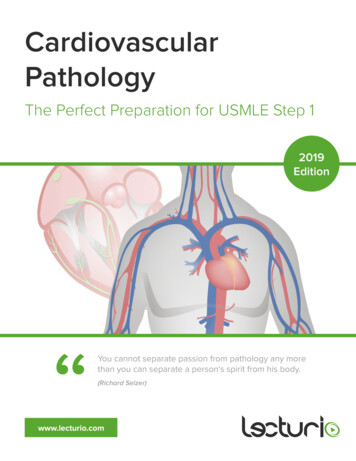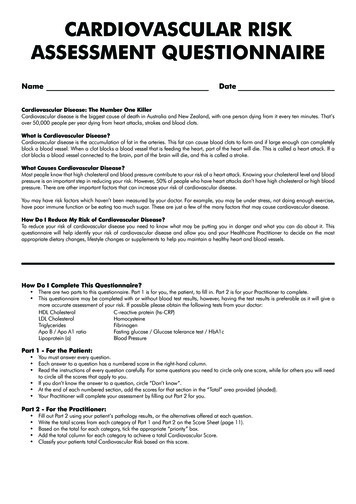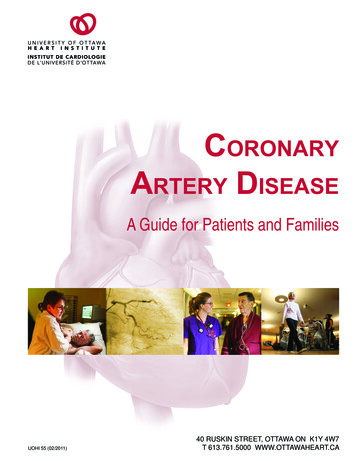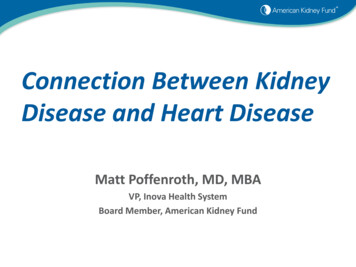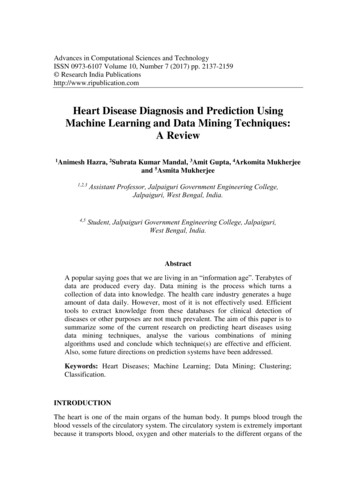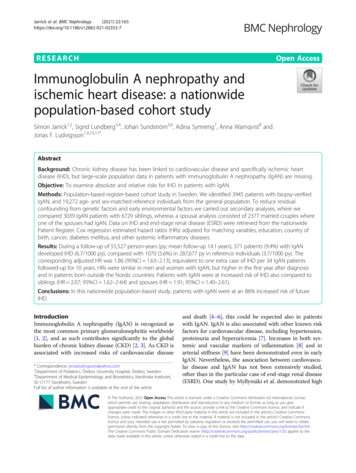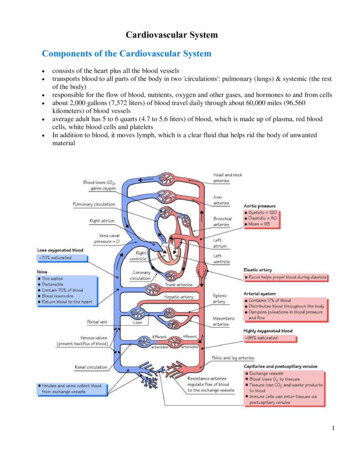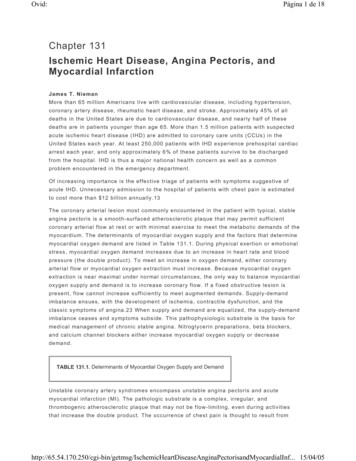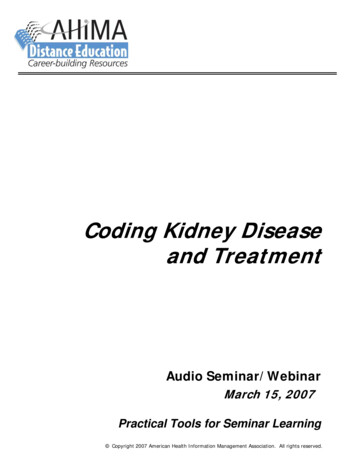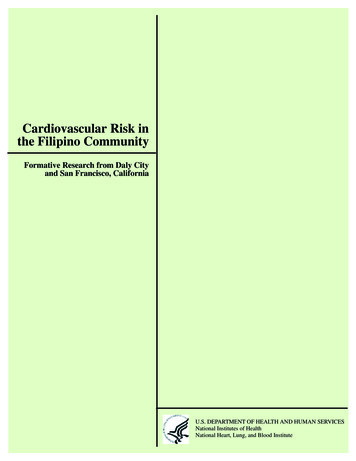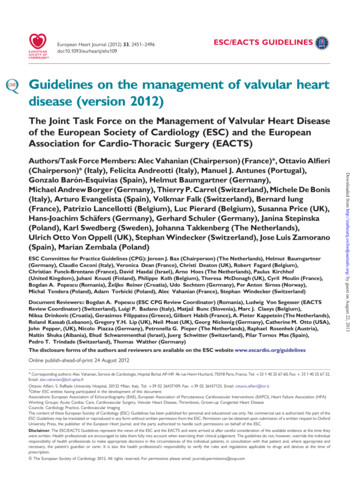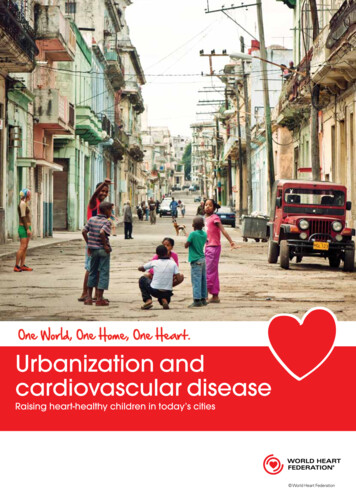
Transcription
Urbanization andcardiovascular diseaseRaising heart-healthy children in today’s cities World Heart Federation
About the World Heart FederationThe World Heart Federation is dedicated to leading the global fight against heart disease and stroke with a focus onlow- and middle-income countries via a united community of more than 200 member organizations. With its members,the World Heart Federation works to build global commitment to addressing cardiovascular health at the policy level,generates and exchanges ideas, shares best practice, advances scientific knowledge and promotes knowledge transferto tackle cardiovascular disease – the world’s number one killer. It is a growing membership organization that bringstogether the strength of medical societies and heart foundations from more than 100 countries. Through our collectiveefforts we can help people all over the world to lead longer and better heart-healthy lives.Visit: www.worldheart.orgJoin us: www.facebook.com/worldheartfederationFollow us: www.twitter.com/worldheartfednymsFor citation purposesSmith, S. et al., 2012. Urbanization and cardiovascular disease: Raising heart-healthy children in today’s cities.[pdf] Geneva: The World Heart Federation. Available at: http://www.worldheart.org/urbanization World Heart Federation 2012All rights reserved. World Heart Federation publications are available online: www.worldheart.orgRequests for permission to reproduce or translate this publication should be addressed to: communications@worldheart.orgQuotes page
Communities – and especially the urban poor – need to be brought into the decisions that affecttheir lives. Opportunities to put health at the heart of the urban policy agenda exist, and it is timefor all sectors to work together toward innovative and effective solutions that mitigate healthrisks and increase health benefits.Dr Margaret Chan, Director-General, World Health Organization (WHO)[WHO and UNHABITAT, 2010]It should be a major concern for all of us to know that malnutrition during the first 1000 days of lifecan leave a legacy of heart disease, diabetes and a shortening of the life span.Sir George Alleyne, Director Emeritus, Pan American Health Organization (PAHO)History is being written on the hearts of our children.Professor K. Srinath Reddy, Chair, Scientific Policy and Initiatives Committee (2011-2012),World Heart FederationWhere people live affects their health and chances of leading flourishing lives. Communities andneighbourhoods that ensure access to basic goods, that are socially cohesive, that are designedto promote good physical and psychological well-being, and that are protective of the naturalenvironment are essential for health equity.Commission on Social Determinants of Health (CSDH)*[CSDH, 2008]*The CSDH is a Commission established by the WHO in 2005 to respond to increasing concern about persisting andwidening inequities in health.Think about what that means for the health of our nation, the healthcare system, when healthykids grow up to become healthy adults—adults who are less likely to suffer from illnesses likediabetes and heart disease or cancer that cost us billions of dollars a year.First Lady Michelle Obama[Live United, 2011]
AcknowledgementsUrbanization and cardiovascular disease: Raising heart-healthy children in today’s cities was developed by the WorldHeart Federation, a non-governmental organization committed to leading the global fight against heart disease andstroke, with a focus on low- and middle-income countries. The report text was guided by a team of experts at theWorld Heart Federation, including: Professor Sidney C. Smith Jr, MD, President (2011–2012); Johanna Ralston, ChiefExecutive Officer; and Professor Kathryn Taubert, PhD, Chief Science Officer.Editorial support was provided by the following members of the World Heart Federation team: Charanjit K. Jagait,PhD, Director of Communications & Advocacy; and Amy Collins, Advocacy & Policy Coordinator.The megacities research was completed by Leela Barham to support the World Heart Federation in producingthis report. Leela is an independent health economist: The World Heart Federation would like to give their appreciation to: HRIDAY – SHAN (Health Related InformationDissemination Amongst Youth – Student Health Action Network), the Chinese Society of Cardiology, and the KenyanCardiac Society for their time in researching country data and for their contributions to this report.
ContentsForeword3Introduction4Chapter One: Cardiovascular disease and urbanization61.1 Urban growth in the 21st Century61.2 The relationship between urbanization and heart health61.3 Cardiovascular disease burden61.4 Why a global response is needed8Chapter Two: Addressing the burden102.1 Reasons for action: returns for individuals, society and the economy102.2 Reasons for action: a child’s right to health102.3 Taking action: a whole-of-society response11Chapter Three: Tackling risk factors123.1 Physical inactivity123.2 Under- and over-nutrition143.3 Tobacco use173.4 Rheumatic fever and rheumatic heart disease19Chapter Four: Cardiovascular health in today’s megacities224.1 Megacity research224.2 São Paulo234.3 Shanghai254.4 Mexico City264.5 Buenos Aires284.6 Mumbai304.7 Tehran324.8 Nairobi and slum settlements34Chapter Five: Conclusions and recommendations385.1 Conclusions385.2 Recommendations395.3 Summary41References421
2
ForewordRecent evidence suggests that the risk ofdeveloping cardiovascular disease (CVD)begins even before birth, during foetaldevelopment. This risk increases furtherduring childhood, due to exposure to riskfactors: unhealthy diet, physical inactivity,tobacco use and harmful use of alcohol[IOM, 2010].For many of today’s children, this exposureis increased due to the negative impacts ofurbanization. Children living in towns andcities, particularly in low- and middle-incomecountries (LMICs) face very real and growinghealth risks: crowded living conditions, airand water pollution, inadequate sanitation,limited green space and an overwhelmingdisplay of tobacco, alcohol and fast-foodmarketing, all disproportionately affectingcertain populations and potentially imposinglimitations on how they live, work, eat andsustain themselves.Like many of you reading this report –and more than half of the world’s 7 billionapproximate inhabitants – I live and workin an urban area. My hometown hasprovided me with increased access to socialservices, including health and education;the opportunity to buy fresh vegetablesand fruit; and the chance to enrich my lifethrough various cultural activities. Yet, theseadvantages must not mask the fact thatindividuals living in cities, particularly in LMICs,are likely to have limited options aroundheart-healthy behaviour. Around one-thirdof urban dwellers, amounting to nearly onebillion people, live in urban slums, informalsettings, or sidewalk tents [United Nations,2010]. Individuals living in these conditionsoften face diets of low nutritional value, withlimited health-services available. Those livingin more luxurious residential settings may stillbe constrained in making healthy choices,with unsafe outdoor space leading to a moresedentary lifestyle or with the pressures ofcity-life driving harmful tobacco use or alcoholconsumption. Such restrictions and influencesconstrain individuals in behaviours that predispose them to CVD; for them, there is nooption to choose a healthier lifestyle.With this report, the World Heart Federationcalls for urgent action to protect children’sheart health in the world’s most populouscities. We launch the S.P.A.C.E approach; anew guiding principle to make cities hearthealthier for the children who live in them.We recognize that the approach may not befully applicable or affordable for all nationscurrently experiencing the rapid urbanizationof their populations, but it is hoped that thisreport encourages policy makers to takeaction in at least one, if not all, of its fiveelements: Stakeholder collaboration, PlanningCities, Access to healthcare, Child-focuseddialogue and Evaluation. We are optimistic; asyou will read in the coming pages, informedaction by governments and other stakeholderscan dramatically reduce the level of CVDrisk, and we look forward to celebrating yourefforts and successes.At the World Heart Federation, we know thatCVD is a global health emergency affectingBecause the risk of CVD can be mitigated byall ages and socioeconomic clusters. We alsochanges to behaviour, there is a widespreadknow that healthy options made availableperception that CVD – including heartin early life are the best preparation for adisease and stroke – is a “lifestyle” disease.heart-healthy life. This report is the resultHowever, many of the challenges posed byof a literature review, undertaken as anurban environments cannot be addressedobservational exercise to provide a snapsimply through individual lifestyle choices. For A misconception that CVD is a lifestyle disease shot of trends in world heart health relatedmost of the world’s people, and especiallythat primarily afflicts older, affluent populations to urban-living. It is not intended to beits children, where a person lives intrinsicallyhas until now led to the virtual absence of vital conclusive, and we look to our colleagues inaffects their health and life options.investment in the prevention and treatment of academia to build on this research to providea new evidence base in which to groundCVD and other non-communicable diseasespolicy and practice change. Meanwhile, weAction to address urban health risks is(NCDs). However, CVD is a public healthhope that whether you are a policy maker,therefore essential, to protect the healthemergency requiring an urgent responsehealthcare professional, urban planner, parentof our children and the prospects of futurefrom all governments as recognized by thegenerations. Efforts to prevent CVD andor any other stakeholder concerned with childUnited Nations (UN), on 19 September 2011,protect people from the risk factors thathealth, you enjoy reading this report, and thatwhen the Political Declaration from the UNit inspires you to take action now to ensurecause it are required throughout people’sHigh-Level Meeting (HLM) on NCDs wasthat children everywhere can live safe andlives, from conception through to life end (aunanimously adopted. This is a significantlife-course approach).healthy lives. As estimates suggest seven outmilestone for the CVD community andof 10 people will live in cities by 2050 [Londonthe Declaration puts a clear emphasis onSchool of Economics and Deutsche Bank’sWith this publication, we aim to put childrenprevention through a “health in all policies”Alfred Herrhausen Society, 2007], focusing onand communities first; to recognize theand life-course approach to health. Theurban living is critical.challenges city-living children face on a dailyDeclaration also highlights that this responsebasis, to raise awareness of the constraintsshould not come from the health sector aloneon them making heart-healthy choices, and to but from a multi-sector collaboration; put intoProfessor Sidney C. Smith Jr, MDdispel the myth that CVD can be preventedcontext, this means that the promotion ofthrough “simple” behaviour changes byhealthy diets, physical activity and tobaccoindividuals. We also aim to demonstrate thatcontrol initiatives must happen through crossby taking action to curb children’s exposuresector urban and development planning thatto CVD risk factors, particularly in urbanincludes transportation, agriculture, trade,settings, the health and socioeconomicfinance and education with the engagementWorld Heart Federationburden caused by CVD worldwide can beof all community stakeholders – at the local,President (2011–2012)dramatically reduced.regional and national level.3
IntroductionCVD is the number one cause of deathglobally [WHO, 2011(d)]. Contrary tocommon belief, the burden of morbidityand mortality from heart disease isnot confined to affluent, high-incomecountries; with the exception of subSaharan Africa, CVD is the leadingcause of death in the developing world[Gaziano, 2007].The majority of deaths due to CVD areprecipitated by risk factors such as high bloodpressure, high cholesterol, obesity, or thepresence of diabetes, which can, to a largeextent, be prevented or controlled throughthe consumption of a healthy diet, regularexercise and avoiding tobacco. The rise ofCVD in LMICs has therefore been linked toprogressive urbanization and the coinciding“globalization of unhealthy lifestyles, whichare facilitated by urban life – tobacco use,unhealthy diets, physical inactivity and harmfuluse of alcohol” [WHO and UNHABITAT, 2010].However, the use of the word “lifestyle”within discussions about urbanization andheart health can be problematic. It leads tothe incorrect assumption that a healthy orunhealthy lifestyle is based upon the wayin which a person chooses to live; theirengagement in physical activity, their foodchoices, and their behavioural preferences.As highlighted by Stuckler, Basu and McKeea common fallacy exists that NCDs, includingCVD, “stem from a moral failure—thatweakness of will leads to obesity or sedentarylifestyles” [Stuckler, Basu and McKee, 2011].Although urbanization brings with it manygreat lifestyle opportunities (includingemployment choices, educational prospects,social connections and political mobilization),inherent to city life are practical and logisticalobstructions to adopting heart-healthybehaviours. Urban living can also removethe autonomy of individuals to make healthychoices, via dominant pressures andinfluences to adopt unhealthy ones [Stuckler,4Basu and McKee, 2011]. As such, urbanizationposes serious health challenges.Children are particularly vulnerable to thenegative health aspects associated with citylife, as they have the least independence fromand are most manipulated by their living andbuilt environment. The joint UN-HABITAT/WHOreport entitled Hidden Cities: Unmasking andOvercoming Health Inequities in Urban Settingshighlights that broad physical, economic andsocial determinants influence the health ofcity dwellers [WHO and UNHABITAT, 2010].Children are likely to be deprived of choiceacross all determinants, and forced into nonheart-healthy lifestyles and circumstances.Considering the built environment, in manycases, urbanization has occurred so rapidlythat the development of a city’s infrastructureis lagging behind the movement of people intoit. As a result, people reside in insubstantialhousing conditions, ranging from slumsto cardboard boxes at the side of a street.Children living in physical environments thatlack green spaces, or are situated in unsafeareas characterized by high crime rates, will nothave the choice to play and be active outside;consequently these children are forced to besedentary in their lifestyle. As another example,children living in crowded environments maybe at increased risk of rheumatic fever (RF),and its serious complication, rheumatic heartdisease (RHD), which causes damage to theheart muscle and heart valves. By nature oftheir dependence, these children are subjectedto their living environments, and are unable tomake the “choice” to move elsewhere.Considering economic determinants, thechanging financial circumstances and lifepatterns for people moving from rural to urbanenvironments can greatly impact heart health.Economic position may determine dietaryintake, for example. At the far-end of the scale,families living in the poorest circumstancesmay face malnutrition, a critical componentof CVD risk. Due to the concept of foetalprogramming, infants born to women whoexperience malnutrition during pregnancy are atincreased risk of CVD later in life [NCD Alliance,2011(a)]. On the other side, excessive weightgain or maternal obesity during pregnancyhas been associated with obesity in children,although evidence is inconsistent [IOM, 2010].In the middle of the scale, children growingup in families of lower- and middle-economicstatus may have restricted options for theirfood intake; for example, if it is cheapest topurchase food from a street vendor or fastfood chain, a family on a limited budget mayhave no choice but to consume unhealthy foodhigh in saturated or trans fat, sugar and salt.For lower- and middle-income families, limitedaccess to healthcare for the treatment of CVDpre-cursors and the prevention of secondarydisease may also fuel the CVD epidemic.However even those living in more affluentcircumstances are at CVD risk, due tooverweight caused by poor diets for example,as influenced by their social environments.The globalization of the food trade has led toa change in dietary patterns and an increasedintake of foods which are often energy densewith low-nutritional value [NCD Alliance,2011(a)]. Children are driven to consume suchfoods, persuaded by industry marketing andconvenience of food access, or because theylack the education and knowledge to knowhow to self-prepare healthier food options.This problem is further exacerbated by lackof physical activity resulting from changesin occupational and leisure activities, as wellas security issues, each inherent to cityliving [WHO, 2008]. Such urban trends arefuelling levels of overweight and obesity thatsignificantly impact on the heart health of cityliving children [NCD Alliance, 2011(a)].In addition, smoking rates are increasingamong youth in several regions of the world[NCD Alliance, 2011(a)]. Children born intomany of the cities in LMICs will be exposedfrom the outset of life to marketing campaigns
that associate tobacco use with glamour,independence and sex appeal, thereforecompromising their ability to make informedchoices about it [NCD Alliance, 2011(a)]. Asimilar story is seen regarding the marketing ofalcohol and subsequent alcohol consumption.but to ensure that health is prioritized duringfuture development planning, to tackle healthchallenges before they are established withincities.Examples of policies that can have a directimpact include: measures to increase theSo, while it may seem relatively straightforward availability of nutritious, healthy food andto “choose” to remain active, to eat healthily,reduce the prevalence of fast-food advertising;and to be tobacco free, the choices childrenbetter planning so that green and outdoorhave are determined by their living conditions.spaces are readily available for exercise andAs one summary of research from sub-Saharan recreation; and, restrictions on tobacco smokeAfrica observes, both lower- and upper-income and alcohol consumption. Many differentgroups in urban settings are prone to CVD riskgroups must work together to develop thesefactors, “the former due to socioeconomicpolicies and improve the urban environmentstressors, limited access to healthcare, andfor our children: national and local governmentspoor diet and the latter to obesity, excess foodand city planners need to consider healthand alcohol consumption, and lack of exercise” outcomes within city planning; business[Wood, 2005].leaders and civil society can make it easierfor children and their parents to make healthyFor children, who are particularlychoices; and schools, hospitals and otherimpressionable, it is therefore vital thatchildren’s services can provide information andtheir living and built environment promoteseducation to create the right environment for aand allows for heart-healthy behaviour. Thehealthy life from the start.links between city living and heart healthconsequently require urgent political attention,It is recognized that many local and nationalleading to the creation of policies to ensure that governments are already tackling the healththe opportunities cities provide for economicchallenges of urbanization. However, in manyand social development are balanced withcities the speed of urbanization has outpacedefforts to reduce their negative impact on thegovernment capacity to build essentialhealth of future generations. To reverse current infrastructures to make life in cities healthytrends, policies need to consider not just[WHO and UNHABITAT, 2010]. A whole-ofsolutions to current urban-health difficulties,society approach is therefore required, withcommitment to action from all governmentalsectors involved in urban planning and health,charities and not-for-profit organizations, civilsociety, and religious leaders. Industry alsoneeds to be more socially responsible and tobe held accountable for actions affecting urbanhealth.This publication is the first to focus on thespecific needs of children, living within citiesand at risk of CVD. It reveals the cross-cuttinglinks between urban life, the dependencyof children on their living environment, andprecursors for poor heart health. It providesinformation about the CVD risk factorsassociated with city living and presents casestudies of some of the world’s megacities(defined as a city or metropolitan area inwhich more than 10 million people live), witha focus on LMICs: it thus concludes that fromShanghai to Mumbai, and from Buenos Airesto Mexico City, more has to be done to ensurethat children have the capacity to live healthily.As a result, this publication draws attention tothe need to prioritize action in the fight againstCVD, for the benefit of both child health andeffective urban development. It also aims tostimulate discussion on the steps that must betaken and by whom. By working together, wecan overcome the health challenges presentedby the world’s cities and prevent the increasingburden of CVD.5
Chapter OneCardiovascular disease andurbanization1.1 Urban growth in the 21st CenturyRecent decades have given rise to a newphenomenon: the birth of the megacity.Previously rural areas have becomeindustrialized; where industrialization hasbeen slower to occur, rural communitieshave frequently seen their populationmigrate to urban areas. These sociodemographic changes have led to theformation of densely populated metropolitanareas; our world now has 21 megacities, anumber which is projected to grow [UnitedNations Department of Economic andSocial Affairs, 2006]. According to recentprojections, the world population will likelyreach 9.3 billion by the middle of this century[United Nations Department of Economicand Social Affairs, 2011].It is estimated that 75 per cent of thispopulation – approximately 7 billion people,and the equivalent of the entire worldpopulation of today – will be living in citiesby 2050 [London School of Economics andDeutsche Bank’s Alfred Herrhausen Society,2007] (Box 1).Although urbanization offers numerousopportunities, the shift towards urbanlife also brings with it new and uniquehealth challenges. Over the past decade,urbanization and health have becomeincreasingly “hot topics” and studiesinvestigating a link between city livingand negative health outcomes have beencompleted, particularly by those in focusedfields (e.g. environmental health, publichealth, and lifestyle-related behaviouralhealth) [De Leeuw, 2001]. A considerablebody of knowledge examining therelationship between urbanization and healththerefore exists [De Leeuw, 2001].In recognition of this fact, the WHO chosethe theme of “urbanization and health” forWorld Health Day at the beginning of thisdecade. As Dr Jacob Kumaresan, Director ofthe WHO’s Centre for Health Development6explained, “The world is rapidly urbanizingwith significant changes in our livingstandards, lifestyles, social behaviour andhealth. While urban living continues to offermany opportunities, including potentialaccess to better healthcare, today’s urbanenvironments can concentrate health risksand introduce new hazards” [WHO, 2010(b)].heart disease risk may be higher amongstaffluent black South Africans as exposure tourban dietary trends occurs. For example,the globalization of Western diets increasesthe dietary intake of fat and animal protein,leading to increases in “bad” cholesterollevels of men and women, a risk factor forCVD [Vorster, 2002].Hazards particularly related to city lifeinclude water environment, pollution,accidents, violence and NCDs: CVD,cancers, chronic respiratory diseases anddiabetes. CVD is a group of disorders/diseases of the heart and blood vessels,which can result in negative health eventssuch as a heart attack or stroke (Table 1).The modifiable risk factors for CVD includesmoking, hypertension, dyslipidemia, type2 diabetes, obesity, poor dietary habitsand physical inactivity. These may beexacerbated by city living and its decreasedavailability of safe, green space for exerciseand recreation, increased pressures frommass marketing, and the availability of cheapbut unhealthy food options.Another study considered the relationshipbetween heart health and urban living forchildren aged 10–12 years. Varying degreesof urbanization of the environments of SouthAsian schoolchildren were compared withthe prevalence of coronary heart disease riskfactors. The research concludes that urbanizedlifestyle, particularly when combined withother factors like undernourishment, couldbe a major determinant of heart diseasemorbidity and mortality [Hakeem, Thomas andBadruddin, 2001].1.2 The relationship betweenurbanization and heart healthThe links between urbanization andheart health across a number of regionsglobally are well established in publishedliterature. For example, a spatial analysis ofurbanization, migration and CVD risk factorsin China indicates that improved standardsof living and life expectancy resulting fromrapid rural-urban migration are countered byan increase in CVD risk factors [Adamo, etal., 2010].A separate piece of research into theemergence of CVD during the urbanizationof South African countries concludesthat deaths caused by stroke amongstblack South Africans are likely related toan increase in hypertension, obesity, andsmoking habit [Vorster, 2002]. In addition,the authors suggest that future ischaemicThe above examples are just a sample ofpublished research, further illustrations ofwhich are provided throughout this report.Such studies and literature are significant, asthe findings provide the evidence base forthe impact of urban settings on heart health.When considered in context of the burdenof CVD, they unmask the importance ofaddressing CVD risk within urban planningto protect the health, economic stability andthe sustainability of our future societies.1.3 Cardiovascular disease burdenIn 2004, an estimated 7.2 million deathswere due to coronary heart disease and5.7 million were due to stroke [WHO,2011(d)]. Over 80 per cent of these deathstook place in LMICs, and occurred almostequally in men and women [WHO, 2011(d)].Looking forward, by 2030 almost 23.6 millionpeople will die from CVD; it is thereforeprojected to remain the single leading causeof death globally [WHO, 2011(d)].The global burden of CVD is substantial.The cost of disease to countries’ healthcare
systems is incredibly high; in China forexample, annual direct costs are estimatedat more than U.S. 40 billion or 4 per centof gross national income [Gaziano, 2007]. Atotal 25 per cent of South African healthcarespending is devoted to the direct treatmentof CVD [Gaziano, 2007]. Data from theUnited States of America show that CVDand stroke costs over U.S. 286 billion indirect and indirect annual costs, more thanthe estimated cost of all cancers at U.S. 228billion [Roger, et al., 2011].blow from CVD as they are impacted bothdirectly and indirectly. Congenital heartdisease (CHD) and acquired heart diseaseboth affect children, inflicting physicalsymptoms of disease which are particularlyburdensome to children in LMICs. Manyof these children die prematurely becauseof late diagnosis and/or lack of accessto appropriate treatment [NCD Alliance,2011(b)]. Those who survive may face alifetime of disability caused by a diseasewhich is not well-managed.CVD is also responsible for 10 per cent ofthe disability adjusted life years (DALYs)*lost in LMICs, and for 18 per cent of DALYslost in high-income countries [WHO, 2004(a)].The cost of CVD to families and society istherefore high and escalating, caused byboth a loss of production (and consequentlyincome) from the person with CVD, or fromtheir caregivers who cease to work [Gaziano,2007]. This economic loss is exacerbatedin the developing world where CVD affectsa high proportion of working-age adults[Gaziano, 2007]. For these reasons, CVD,alongside other NCDs, has been identified asone of the biggest threats to businesses andeconomies of the 21st century.In addition to this, the life chances ofchildren are affected by the morbidity,mortality and disability caused by CVDamongst adults. A child who loses a parentdoes not only have to endure the emotionalimpact of their death, but also faces aneconomic struggle living within a one- or noparent family. Children may be increasinglycalled upon to help with physical labouror household chores, or be taken out ofschool at an earlier age to go to work. Theymay face the burden of caring for a familymember disabled by CVD, or take on therole of parenting siblings. They may beburdened by food insecurity, particularly if afemale family member is disabled by or lostto CVD, since it is women in LMICs whoare often responsible for those jobs crucialto family well-being, for example preparingfood [NCD Alliance, 2011(a)].The CVD burden will be particularly felt bytoday’s children and our future generationsif action is not taken. Children face a doubleChildren born into a family affected byNCDs, including CVD, may also facesocietal stigma and discrimination. Ashighlighted by the NCD Alliance‡, a lack ofawareness and misinformation can provokeNCD-related stigma in many countries[NCD Alliance, 2011(a)]. Girls and boys cansuffer discrimination in education, and at anolder age employment and marriageability,which in many countries represents themain roots to financial security [NCDAlliance, 2011(a
1 Foreword 3 Introduction 4 Chapter One: Cardiovascular disease and urbanization 6 1.1 Urban growth in the 21st Century 6 1.2 The relationship between urbanization and heart health 6 1.3 Cardiovascular disease burden 6 1.4 Why a global response is needed 8 Chapter Two: Addressing the burden 10 2.1 Reasons for action: returns for individuals, society and the economy 10
